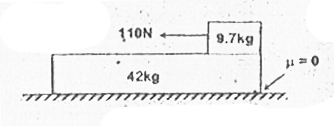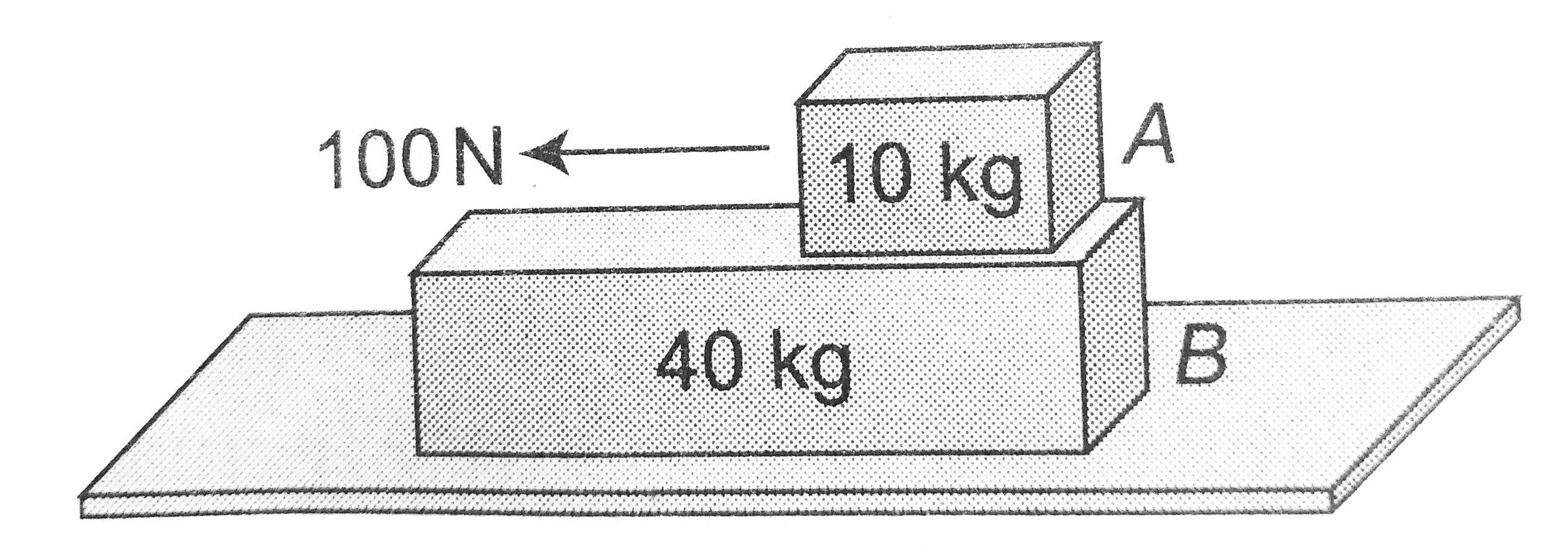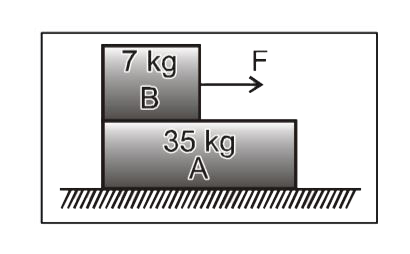A 40 kg slab rests on a frictionless floor . A 10 kg block rests on top of the slab (Fig . 7. 121). The static coefficient of friction between the block and the slab is 0.60 while the kinetic coefficient is 0.40 . The 10 kg block is acted upon by a horizontal force of 100 N . if g = 9.8m/s2 the resulting acceleration of the slab will be :

6.1ms−2
1.52ms−2
1.47ms−2
0.98ms−2
The correct Answer is:D
(d)Force of limiting friction for block =μsmg
=0.60×10×9.8=58.8N
If the applied force is greater than 58.8 N, then the block will move over the slab.
Kinetic friction acition on the block towards right
=μKmg=0.40×10×9.8=39.2N
This is also equal to the force of friction acting on slab towards left.
This is only force acting on slab.
So, acceleration of the slab, a=Fm=39.240=0.98ms−2
Topper's Solved these Questions
Similar Questions
A 42 kg slab rests on a frictionless floor A 9.7 kg block rests on the top of the slab as shown in the figure. The co-efficient of static friction between the block and the slab is 0.53, while the co-efficient of kinetic friction is 0.38. The 9.7 kg block is acted upon by a horizontal force of 110 N. What are the resulting accelerations of
(a) the block, and (b) the slab? (Take g=9.8m/s2)

View SolutionA 40 kg slab rests on a frictionless floor. A 10 kg block rests on top of the slab. The coefficient of friction between the block and the slab is 0.40. The 10 kg block is acted upon by a horizontal force of 100 N. If g=10m/s2, the resulting acceleration of the slab will be

View Solution
Knowledge Check
A 40 kg slab rests on a frictionless floor as shown in the figure. A 10 kg block rests on the top of the slab. The static coefficient of friction between the block and slab is 0.60 while the kinetic friction is 0.40. The 10 kg block is acted upon by a horizontal force 100 N. If g=9.8ms2, the resulting acceleration of the slab will be
 A1m/s2B1.5m/s2C2m/s2D6m/s2
A1m/s2B1.5m/s2C2m/s2D6m/s2A 40kg slab rests on a frictionless floor as shown in the figure. A 10kg block rests on the top of the slab. The static coefficient of friction between the block and slab is 0.60 while the kinetic friction is 0.04 . The 10kg block is acted upon by a horizontal force 100N. if g=9.8m/s2 , the resulting acceleration of the slab will be.
 A1m/s2B1.5m/s2C2m/s2D6m/s2
A1m/s2B1.5m/s2C2m/s2D6m/s2
A 40 kg slb rest on a frictionless floor as shown in the figure. A 10 kg block rests on the top of the slab. The static corfficient of friction between the block and slab is 0.60 while the kinetic friction is 0.40 the 10 kg block is acted upon by a horizontal force 100N. If g=9.8ms2, the resulting acceleration of the slab will be.A1ms2B1.5ms2C2ms2D6ms2
A 40 kg slab rests on a frictionless floor . A 10 kg block rests on the top of the slab . [Fig. 7.81 (a)] . The coefficients of static and dynamic friction are 0.60 and 0.40 respectively . The 10 kg block is pulled by a horizontal force of 100 N . what are the resulting accelerations of (a) the block (b) the slab ? ( g = 10m/s2)

View SolutionBlock A of mass 5 kg is resting on a frictionless floor. Another block B of mass 7kg is resting on it as shown in the figure. The coefficient of friction between the blocks is 0.5 while kinetic friction is 0.4. If a force of 100 N is applied to block B, the acceleration of the block A will be (g=10ms−2) :

View SolutionA block rests on a rough inclined plane making an angle of 30∘ with the horizontal. The coefficient of static friction between the block and the plane is 0.8. If the frictional force on the block is 10N, the mass of the block (in kg) is
View SolutionA block of mass 4 kg is resting on a horizontal table and a force of 10 N is applied on it in the horizontal direction. The coefficient of kinetic friction between the block and the table is 0.1. The work done in √20 s
View SolutionA block of mass 2kg rests on a rough inclined plane making an angle of 30∘ with the horizontal. The coefficient of static friction between the block and the plane is 0.7. The frictional force on the block is
View Solution
